We make technology work for you
Support
- Technical Approach
- Learning hub
- FAQs
Table of Contents
Technical Approach to POWERBIM
Discover the Power of Data for Buildings and Infrastructures.
This is a summary of main features available in POWERBIM for lifecycle Asset Management and Building Operations based in BIM and Data.
Loading Digital Models From Autodesk Construction Cloud
POWERBIM extend the capabilities of Autodesk Construction Cloud when used as BIM Common Data Environment, both platforms are synchronized bidirectionally for many features, while POWERBIM include new ones based in data analytics and asset management.
- POWERBIM models come from Autodesk Construction Cloud environment
- Multiple file formats are allowed (IFC, Revit, Navisworks, AutoCAD, Civil3D, Plant3D, Rhinoceros, fbx, etc.)
- Model federation (including IFC and other formats) and adjust the position of the models independently.
- Possibility to create general dashboards from processes coming for all the Hub (Data Transfers, Revisions, Issues)
- Issues are automatically synchronized to ACC
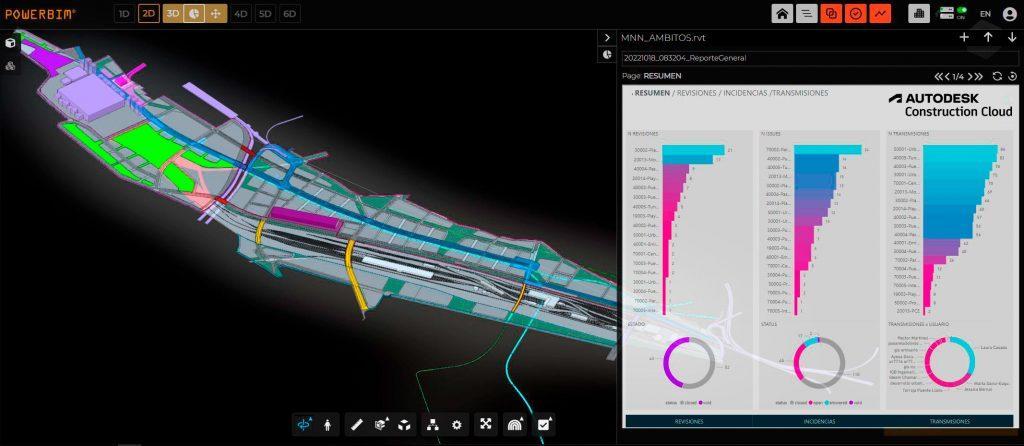
Create Your Custom Dashboards with Microsoft Power Bi
POWERBIM is a unique platform in data analytics automation. Users are able to create custom data reports in Power Bi from the information inside digital models loaded in Autodesk Construction Cloud, connecting interactively data tiles to related components.
The goal is to create a robust layer of data structuration of the asset to be ready for next steps in Digital Twin integration for Design, Construction or Facility Management purposes.
- Invoke attributes from models loaded in POWERBIM to generate your own standard based in your information requirements
- Connect and merge external sources of data coming from files, cloud platforms or external software using Microsoft Power Bi features
- Connect to POWERBIM processes to create dashboards (asset inventory, issues, rulesets or tables created for each project)
- Once your custom report is ready you will be able to use it for all your projects
- Data analysis can be used for multiple purposes for AECO industry (auditing models, integration clash detection results, quantity take off, bill of quantities, timeline management, energy simulations and much more)
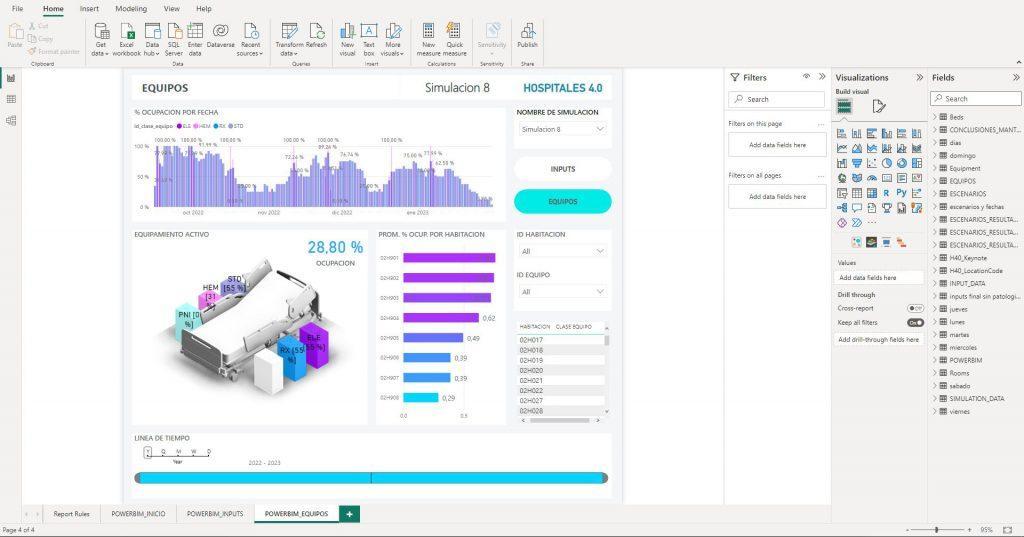
Collaborate In Real Time Using Data Analytics
Discover a new way to collaborate with stakeholders using data analytics dashboards combined to BIM methodology, by creating your own KPIS related to your requirements, or automating the identification of components that match with your rules.
Collaborating trough data insights your team will have data governance from your assets, that can be grouped by categories, assigned to issues or working orders to send to external systems, or attaching relevant information from your Common Data Environment.
- Roles in Autodesk Construction Cloud are combined to POWERBIM roles based in data accessibility
- BIM Collaboration Format (bcf) OpenBIM standard is integrated for Issue Management
- Issues synchronized to the CDE are extended in POWERBIM, users will be able to attach documents, links, videos and can be integrated to CMMS or BMS Systems to automate building operations
- POWERBIM automates the identification of assets in your digital model from rulesets, so you can create your inventory based in your criteria and assign relevant information.
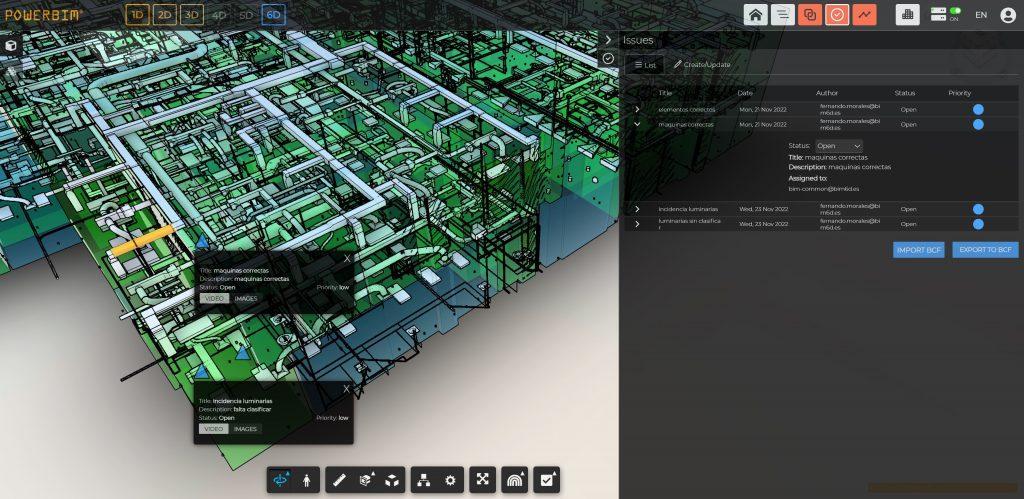
Activate One or Multiple Dimensions for Each Project
Each project is different, not all digital models will be used for building operations or simulating energy performance scenarios. We understand data is valuable at every stage, for different purposes. In POWERBIM you can activate dimensions at any moment you need, each one is a specialty:
1D – Quality Assurance and Control, datatables, rulesets to be applied to create list of components grouped for inventory creation or just to organize them by a classification system
2D – Document Management, being able to create screenshots, animations from them, data transfer between Autodesk Construction Cloud or other Data Management platform like Microsoft SharePoint. Assign documents and links to assets.
3D – BIM / GIS environments, Model Federation and Coordination works
4D / 5D – Creating Quantity Take Offs and Bill of Quantities linked to BIM components in an easy way.
6D – This dimension is intended to simulate data coming from multiple sources for energy or sustainability performance, asset management, building operations, predictive analytics or computer vision.
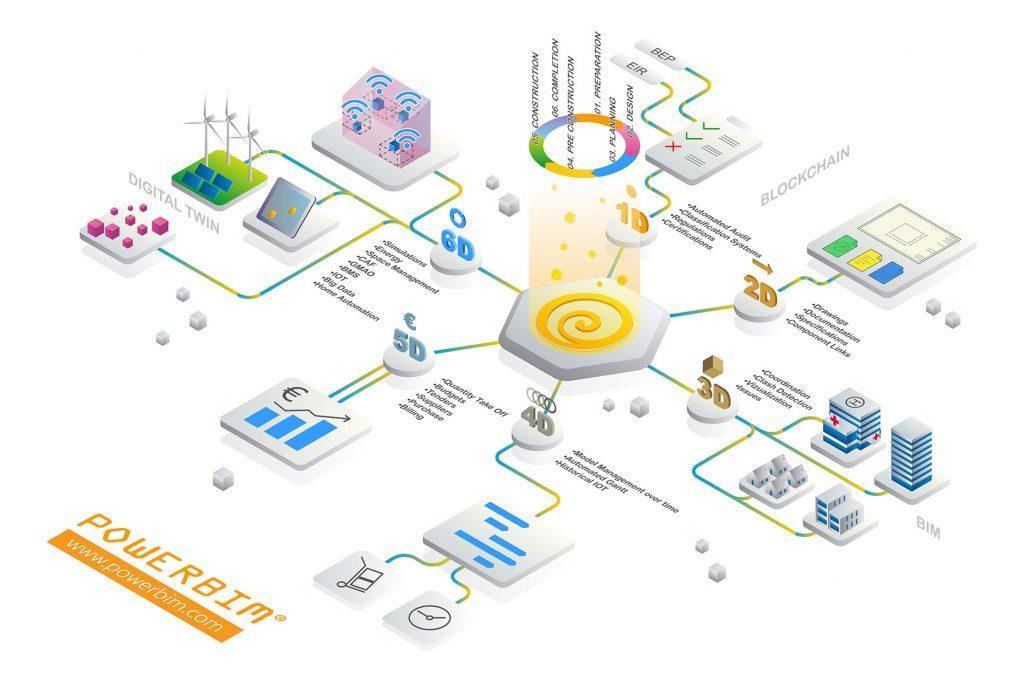
Integrate Your Systems for Lifecycle Asset Management
The goal of digitizing your assets is to simulate multiple scenarios for the systems that critically impact an organization’s business model.
The Return of Investment in DigitalTwins is about 30% for Construction and Facility Management regarding standard technologies. This is thanks in part to the immediacy and simplicity of accessing the information you want to manage (no other) and thanks to have the possibility to anticipate to future problems by creating predictive analytics based in your current data.
Some use cases we have been involved in POWERBIM integrations:
- Unmanned Systems for Remote Inspection (drones, cameras)
- ERP integration for business data connected to BIM spaces
- Monitoring and simulating people positioning in buildings or evacuation simulations
- Smart City Data + Smart Building Data, connected
- BMS integration for HVAC systems
- Scada integration for Industrial or Healthcare
- IoT devices and multimedia data in real time or historic
- Energy and Sustainability Simulations compared to real-time data
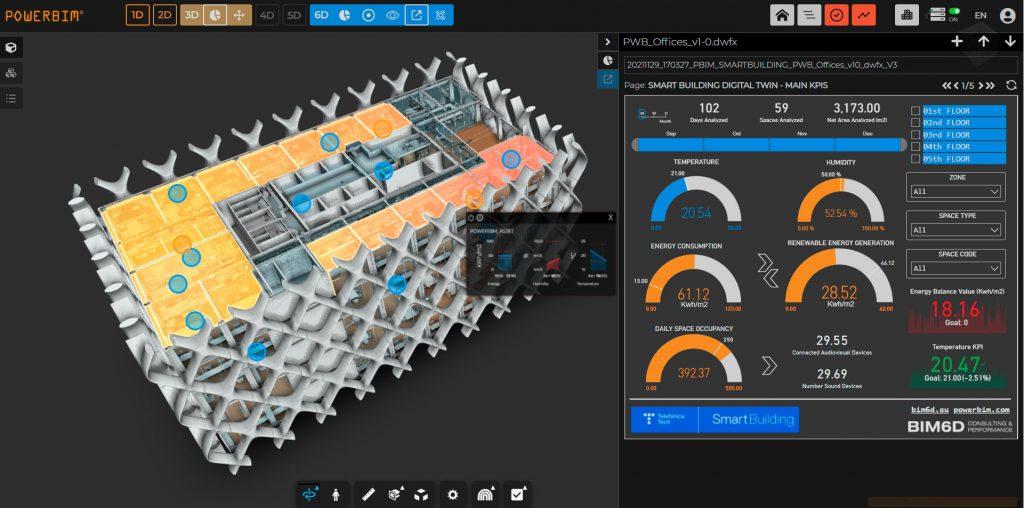
Scale Your Assets from Smart Buildings to The Smart City
If you need to manage multiple assets in a specific location or plot area, you will be able to create a cluster, this is a group of projects interacting between them and with the urban environment. Using GIS technology you will be able to create multiple layers of information, including real time public and private data, or custom integrations on demand.
The goal is being able to manage Smart Buildings integrated to Smart Cities, combining BIM and GIS connected interactively.
Users will be able to create 3D shapes in GIS as new assets in specific locations
Assets can be assigned to a timeline so Asset Manager will be able to plan the growth of the real estate business
User will be able to assign BIM models to 3D shapes in GIS, linking BIM development to GIS
Multiple layers of data can be created, including loading GLTF models automatically created in POWERBIM
Public real time data available in the city, or custom integrations can be included, to create a digital ecosystem of data in multiple scales (Cities + Buildings)
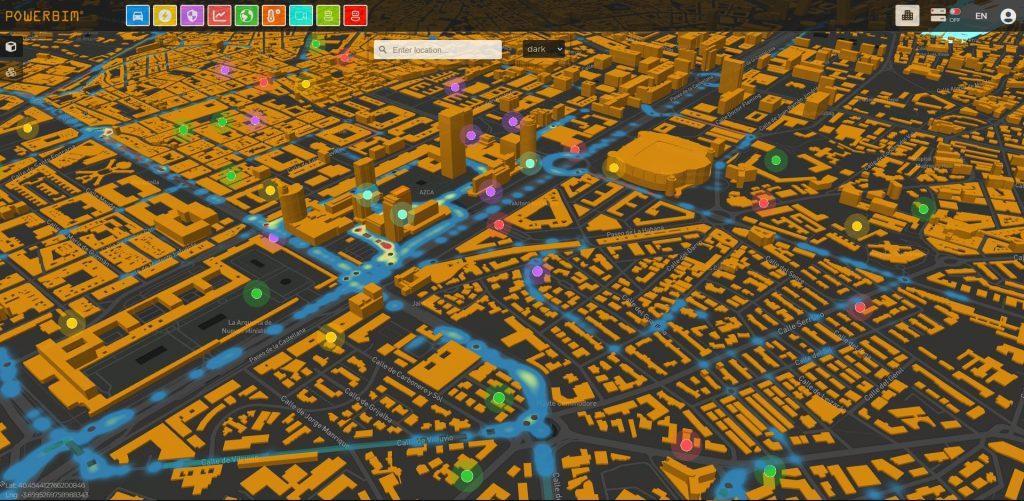
Remote Building Operations with Simulations And Artificial Intelligence
Once POWERBIM is running for one or multiple assets, integrating multiple sources of data, is time to simulate and to take profit of Digital Twins using Artificial Intelligence. The power of data is your hands.
POWERBIM is the unique platform that allows using advance analytics from Microsoft Azure Services automatically integrated to Autodesk Construction Cloud. Nevertheless, other options are available and others coming. We list below a list of integrated technologies for Digital Twins available in POWERBIM.
- Microsoft Azure (IoT Hub / Synapse Analytics / Cognitive Services )
- Siemens Mindsphere Platform (Industrial IoT infrastructure)
- Amazon Cloud Services
- Google Cloud Services
- CMMS / CAFM / IWMS platforms
- Scada platforms
- BMS / EMS Platforms
- ERP Cloud Solutions
- IoT devices and systems
- Any Cloud Based Solution on demand
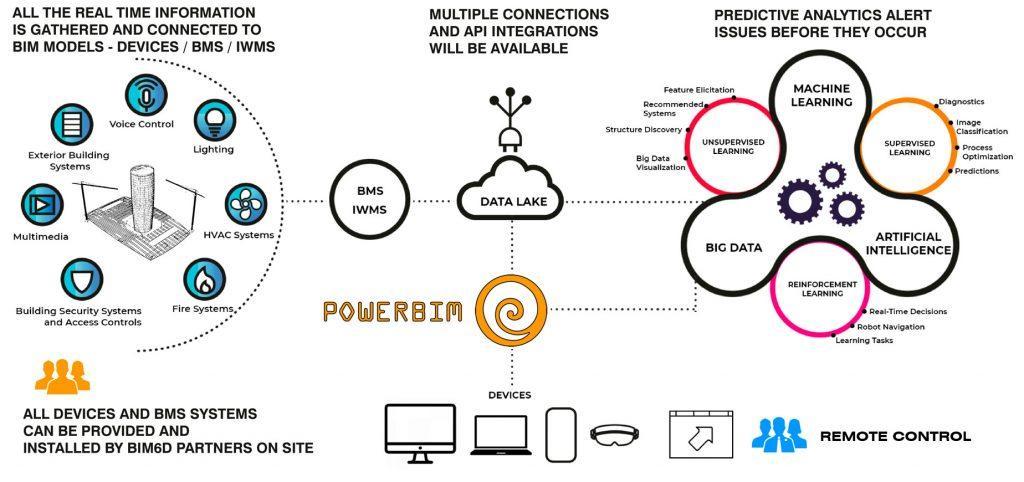
Take a quick tour to see how Powerbim works
Uploading and Opening Models
Creating Automatic Reports
Creating Groups and Issues
Creating a Quantity Take Off Report
Powerbim Sync Manager Editor
BIM Automated
Data Audit
POWERBIM first needs a HUB owned by the client to which to integrate our solution, in this way POWERBIM will read the BIM models of any project that is activated, it is the way to take advantage of the potential of the CDE – Autodesk Construction Cloud, extending its functionalities with those of POWERBIM, based on data management and asset management.
YES, to login to POWERBIM, it is necessary to have an Autodesk account (it is created for free at autodesk.com) and the user accessing it must have access permissions to the Hub and POWERBIM projects.
The list of files supported for display loading in POWERBIM is very extensive, all the files allowed by the Autodesk Platform Services system that you can view at this link: https://aps.autodesk.com/en/docs/model-derivative/ v2/developers_guide/supported-translations/
Although it is true that for the generation of analytical data reports with Power BI, it makes more sense to use BIM file formats and not so much 3D (rvt, ifc, dwfx, nwd, nwc, dwg that comes from BIM software).
In addition, in POWERBIM we can connect all types of files (PDF, Image, videos, etc.) to a set of grouped objects (assets) interactively, so we can generate a complete inventory and assign documentation to it.
POWERBIM has a complete GIS environment to which we can integrate layers of GIS information and layers of 3D information and data, including real-time data. First of all we can draw a 3d shape in an area within the GIS environment and relate a BIM model to it in order to be able to manage multiple assets in an area, other integrations are possible and available in the implementation process.
On the one hand POWERBIM connects to the Autodesk Construction Cloud, therefore the BIM models and documentation to which they integrate start from the Autodesk environment. On the other hand, the data layer remains in a space assigned to the client in a cloud environment installed on European servers, and the client has full control of this data in the form of Power BI reports.
In the part of integration of data systems external to BIM, we can adapt to the needs of the client, being able to integrate with our own servers or created according to the needs.
With POWERBIM we have been doing all kinds of integrations to systems for more than 4 years, today we can integrate to asset management systems such as BMS, EMS, CMMS, IWMS, Scada, IoT systems, ERP, Simulators and other software. Ideally, the platforms to which to integrate have an API based on web services, if not, we can make custom integrations.
POWERBIM has its own IoT infrastructure so that from the IoT panel we can create systems, create virtual devices and variables, we can even configure limit values for each of the variables. On the other hand, we need a connectivity protocol with real IoT systems (hardware). Once these devices are integrated into our infrastructure, they can be used in all client projects for multiple analytical and management functions.
Dimensions is a way of explaining typical use cases when using BIM methodology. In POWERBIM, the dimensions serve to organize the different functionalities based on the BIM dimensions, each dimension serves a purpose and is a specialty in itself:
1D – Functions of auditing databases and review of BIM models
2D – Document management functions, images, linked files
3D – Functions of 3D visualization, coordination, federation of models
4D – Project timeline management functions
5D – Management functions of measurements, budgets, sales associated with a project
6D – Own asset management and digital twin functions, when connecting with the physical entity to perform real-time or simulated data simulations and other asset management functionalities
POWERBIM allows integration with a multitude of software, including people simulation software, energy simulations, sensors, predictive analysis… POWERBIM acts as a catalyst for information and provides the data analytics layer in combination with the BIM structure and allows those data to be visualized data on the model with various visualization techniques (heat maps, cards, color groups, etc.) or on Power BI data reports interactive with the model.
POWERBIM has several stages in the contracting life cycle, designed to offer the client a quick demonstration of its operation adapted to their needs through the pilot project (the first step to start using POWERBIM), so that once the project is completed pilot, users will be able to opt for a subscription plan with those functionalities and integrations developed in the pilot project.
The cost of the pilot project is very competitive and lasts a short time (between 2 and 3 months generally). The annual subscription cost depends on the number of users that will have the editor role (€75/month) and a price per hour of data consumption once the quota included in the subscription has been exceeded (10h per month per editor user).
The great advantage of the POWERBIM subscription is that it can be used for unlimited projects (all those allowed by Autodesk Construction Cloud) and unlimited users (all those previously registered in Autodesk Construction Cloud).
*POWERBIM subscription does not include the consumption of technical support hours.
For each contracted editor user, POWERBIM allocates 10 hours per month of POWERBIM data usage for any user that has access permissions (including guest users). We have verified that an average company, which has 5 editor users, will have 50h/month of data usage assigned, which is more than enough time for the usual data management tasks in POWERBIM.
Once the quota of hours is exceeded, the administrator can purchase credits to obtain more hours of use, or wait for the following month for the credits to be recharged.
Also say that the credits that are not used in a month, accumulate for the following month, up to a limit of 200 hours.
At the moment, due to the fact that the use of POWERBIM is a pay-per-use SaaS system, it is not possible to offer free demos due to the cost involved. But we are working on a functional package that implies the possibility of offering a reduced version as a test.
We encourage interested users to request the live demo in an online meeting with our technical team and learn about the advantages of a pilot project adapted in scope and budget to suit companies in the AECO sector of any discipline or stage of the project.
Need more help?
If your question was not answered in this section, please contact us and we will gladly get in touch with you as soon as possible.